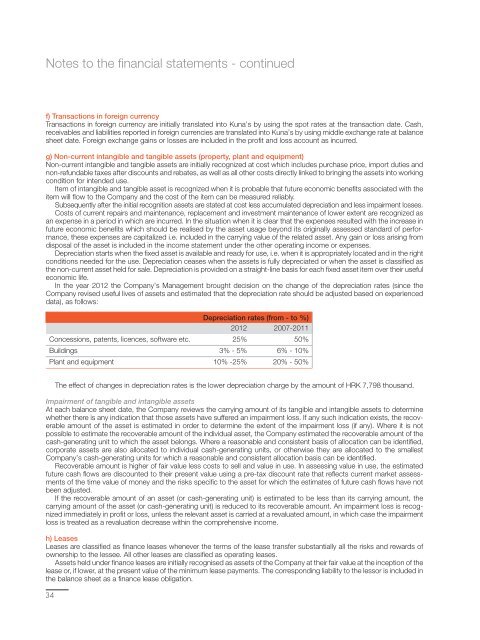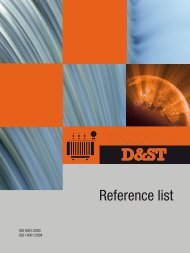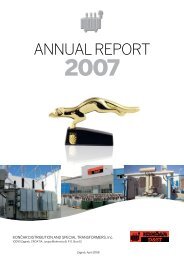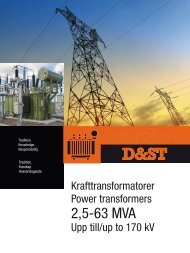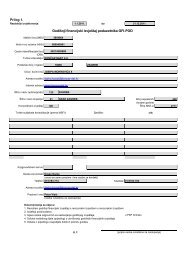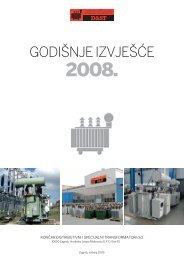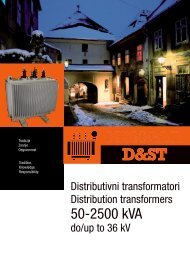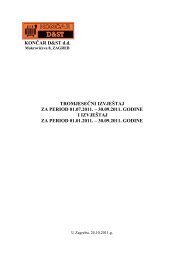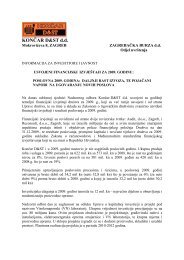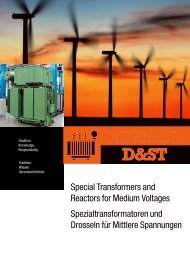Annual Report - KonÄar Distribution and Special Transformers Inc.
Annual Report - KonÄar Distribution and Special Transformers Inc.
Annual Report - KonÄar Distribution and Special Transformers Inc.
Create successful ePaper yourself
Turn your PDF publications into a flip-book with our unique Google optimized e-Paper software.
Notes to the financial statements - continued<br />
f) Transactions in foreign currency<br />
Transactions in foreign currency are initially translated into Kuna’s by using the spot rates at the transaction date. Cash,<br />
receivables <strong>and</strong> liabilities reported in foreign currencies are translated into Kuna’s by using middle exchange rate at balance<br />
sheet date. Foreign exchange gains or losses are included in the profit <strong>and</strong> loss account as incurred.<br />
g) Non-current intangible <strong>and</strong> tangible assets (property, plant <strong>and</strong> equipment)<br />
Non-current intangible <strong>and</strong> tangible assets are initially recognized at cost which includes purchase price, import duties <strong>and</strong><br />
non-refundable taxes after discounts <strong>and</strong> rebates, as well as all other costs directly linked to bringing the assets into working<br />
condition for intended use.<br />
Item of intangible <strong>and</strong> tangible asset is recognized when it is probable that future economic benefits associated with the<br />
item will flow to the Company <strong>and</strong> the cost of the item can be measured reliably.<br />
Subsequently after the initial recognition assets are stated at cost less accumulated depreciation <strong>and</strong> less impairment losses.<br />
Costs of current repairs <strong>and</strong> maintenance, replacement <strong>and</strong> investment maintenance of lower extent are recognized as<br />
an expense in a period in which are incurred. In the situation when it is clear that the expenses resulted with the increase in<br />
future economic benefits which should be realised by the asset usage beyond its originally assessed st<strong>and</strong>ard of performance,<br />
these expenses are capitalized i.e. included in the carrying value of the related asset. Any gain or loss arising from<br />
disposal of the asset is included in the income statement under the other operating income or expenses.<br />
Depreciation starts when the fixed asset is available <strong>and</strong> ready for use, i.e. when it is appropriately located <strong>and</strong> in the right<br />
conditions needed for the use. Depreciation ceases when the assets is fully depreciated or when the asset is classified as<br />
the non-current asset held for sale. Depreciation is provided on a straight-line basis for each fixed asset item over their useful<br />
economic life.<br />
In the year 2012 the Company’s Management brought decision on the change of the depreciation rates (since the<br />
Company revised useful lives of assets <strong>and</strong> estimated that the depreciation rate should be adjusted based on experienced<br />
data), as follows:<br />
Depreciation rates (from - to %)<br />
2012 2007-2011<br />
Concessions, patents, licences, software etc. 25% 50%<br />
Buildings 3% - 5% 6% - 10%<br />
Plant <strong>and</strong> equipment 10% -25% 20% - 50%<br />
34<br />
The effect of changes in depreciation rates is the lower depreciation charge by the amount of HRK 7,798 thous<strong>and</strong>.<br />
Impairment of tangible <strong>and</strong> intangible assets<br />
At each balance sheet date, the Company reviews the carrying amount of its tangible <strong>and</strong> intangible assets to determine<br />
whether there is any indication that those assets have suffered an impairment loss. If any such indication exists, the recoverable<br />
amount of the asset is estimated in order to determine the extent of the impairment loss (if any). Where it is not<br />
possible to estimate the recoverable amount of the individual asset, the Company estimated the recoverable amount of the<br />
cash-generating unit to which the asset belongs. Where a reasonable <strong>and</strong> consistent basis of allocation can be identified,<br />
corporate assets are also allocated to individual cash-generating units, or otherwise they are allocated to the smallest<br />
Company’s cash-generating units for which a reasonable <strong>and</strong> consistent allocation basis can be identified.<br />
Recoverable amount is higher of fair value less costs to sell <strong>and</strong> value in use. In assessing value in use, the estimated<br />
future cash flows are discounted to their present value using a pre-tax discount rate that reflects current market assessments<br />
of the time value of money <strong>and</strong> the risks specific to the asset for which the estimates of future cash flows have not<br />
been adjusted.<br />
If the recoverable amount of an asset (or cash-generating unit) is estimated to be less than its carrying amount, the<br />
carrying amount of the asset (or cash-generating unit) is reduced to its recoverable amount. An impairment loss is recognized<br />
immediately in profit or loss, unless the relevant asset is carried at a revaluated amount, in which case the impairment<br />
loss is treated as a revaluation decrease within the comprehensive income.<br />
h) Leases<br />
Leases are classified as finance leases whenever the terms of the lease transfer substantially all the risks <strong>and</strong> rewards of<br />
ownership to the lessee. All other leases are classified as operating leases.<br />
Assets held under finance leases are initially recognised as assets of the Company at their fair value at the inception of the<br />
lease or, if lower, at the present value of the minimum lease payments. The corresponding liability to the lessor is included in<br />
the balance sheet as a finance lease obligation.


